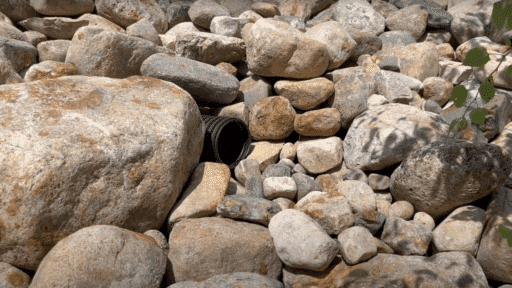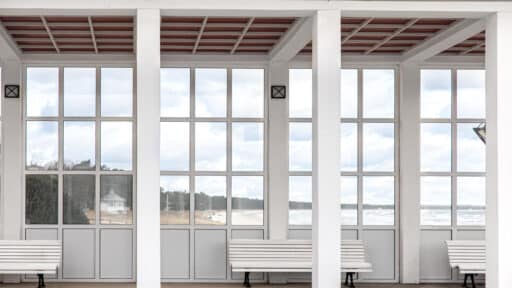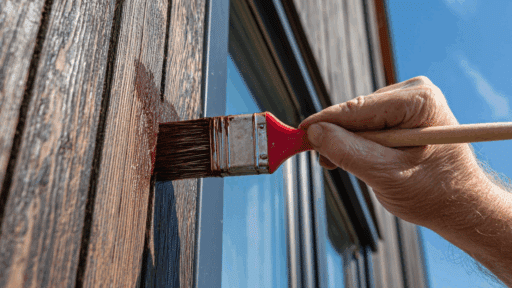Working with concrete requires patience and proper knowledge to achieve lasting results.
Many builders, both amateur and professional, struggle with timing their projects correctly because they don’t understand the fundamental differences between drying and curing.
The success of your concrete project depends heavily on respecting these two distinct processes. Getting the timing wrong can lead to weak, cracked, or damaged concrete that fails prematurely.
Understanding when your concrete is ready for the next step protects your investment and ensures long-term durability.
The difference between concrete drying and curing can make or break your project. These two processes are often confused, but they serve entirely different purposes in creating strong, durable concrete.
Concrete Drying vs. Concrete Curing: What’s the Difference?
Concrete drying refers to the physical process by which moisture evaporates from the surface of freshly poured concrete.
This is what makes the surface feel dry to the touch and allows you to walk on it without leaving footprints.
Concrete curing, on the other hand, is a chemical process in which cement particles react with water to form strong bonds that give concrete its strength.
This hydration process continues for weeks or even months after the concrete is poured, gradually strengthening and making it more durable.
The curing process requires adequate moisture and time to reach its full potential. Interestingly, concrete can cure underwater or in completely saturated conditions, proving that moisture loss isn’t necessary for strength gain.
Understanding this distinction helps explain why rushed concrete projects often fail prematurely.
How Long Does Concrete Take to Dry?
For most standard concrete mixes, the surface will be touch-dry within 24 to 48 hours under normal conditions. However, this timeline can vary significantly based on several factors:
| Concrete Type | Drying Time |
|---|---|
| Thin slabs (2-4 inches) | 24-36 hours |
| Thick slabs (6+ inches) | 48-72 hours |
| High-strength concrete | It may take longer due to a denser composition |
| Quick-setting mixes | Can be touch-dry in 6-12 hours |
Remember, surface drying doesn’t mean the concrete is ready for heavy loads – that’s where curing comes into play.
Factors That Affect Concrete Drying and Curing Times
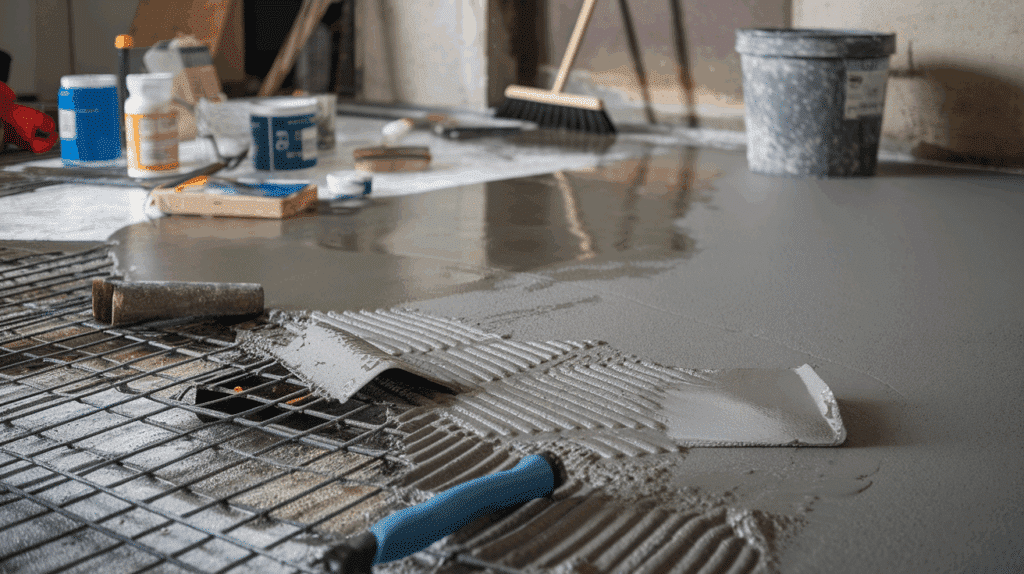
Several environmental and material factors can significantly impact your concrete’s drying and curing timeline:
1. Temperature
Warmer temperatures (70-80°F) accelerate both processes, while cold temperatures (below 50°F) significantly slow them down.
Extreme heat above 90°F can cause rapid surface drying, resulting in cracking and reduced final strength. Cold weather below 40°F can halt the curing process entirely, requiring special heating or insulation measures.
2. Humidity
High humidity slows drying but can help curing by preventing the concrete from drying out too quickly. Desert climates with low humidity can cause surface cracking due to rapid moisture loss.
Ideal humidity levels, ranging from 40% to 60%, provide the best balance for both processes.
3. Thickness
Thicker slabs take longer to dry completely and may require extended curing periods for optimal strength. The center of thick pours can remain moist for weeks while the surface appears dry.
Slabs over 8 inches thick often need specialized curing techniques to ensure uniform strength development.
4. Concrete mix
Different cement types, additives, and water-to-cement ratios all affect timing. Portland cement concrete cures differently than rapid-set or high-early-strength mixes.
Additives such as fly ash or slag can extend curing times while improving long-term durability.
5. Air circulation
Good ventilation speeds drying but may require additional water for proper curing. Strong winds can create uneven drying patterns across the surface.
Indoor projects with poor air movement may need fans to prevent moisture buildup and potential mold issues.
How Long Should Concrete Cure Before Putting Weight on It?
The curing timeline is crucial for determining when your concrete can safely bear weight:
| Load Type | Timing | Strength Level |
|---|---|---|
| Light foot traffic | 24-48 hours | Surface dry |
| Normal use | 7 days | Reaches approximately 70% strength |
| Heavy loads | 28 days | Reaches full design strength |
| Vehicle traffic | 7-14 days | Depending on slab thickness |
Professional contractors often follow the “7-day rule” for most residential applications, but always check your specific project requirements and local building codes.
How to Speed Up Concrete Drying and Curing
When time is of the essence, several techniques can help accelerate the process:
For faster drying
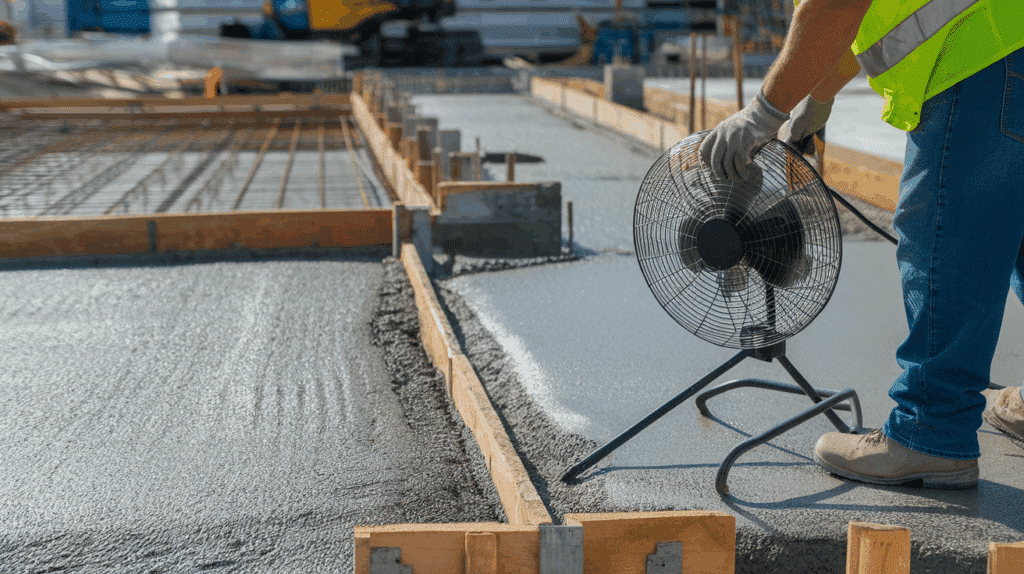
Several methods can accelerate the surface drying process. Improving ventilation with fans helps remove moisture from the air around the concrete surface.
Applying controlled heat can accelerate the process, although you must be cautious to avoid cracking due to rapid temperature changes.
Choosing quick-setting concrete mixes from the start provides faster initial set times for projects with tight deadlines.
For faster curing
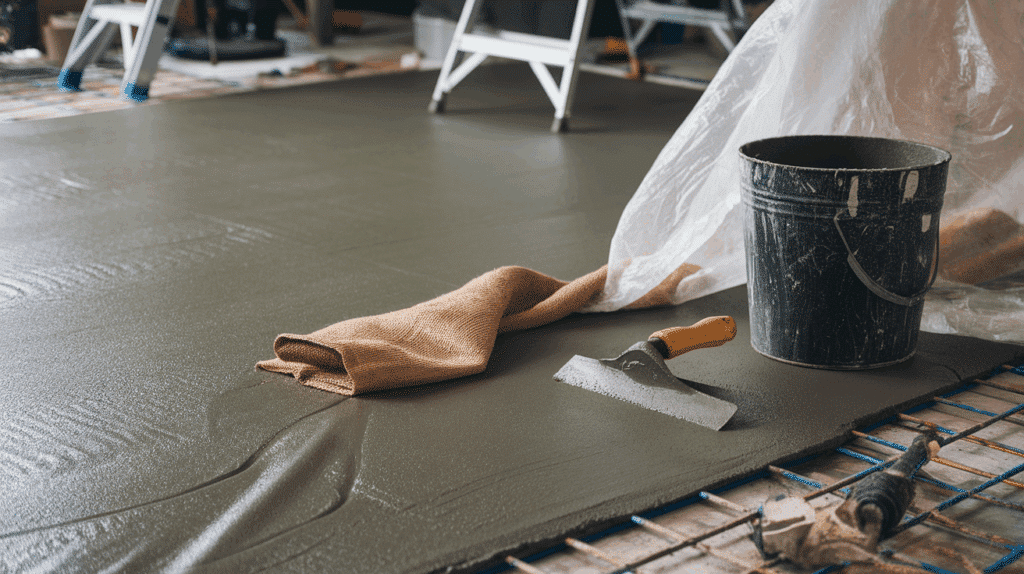
The chemical curing process can also be accelerated through various techniques. Adding concrete accelerators to the mix speeds up the hydration reaction between cement and water.
Using warm water in the concrete mix increases the initial reaction rate; however, the water temperature should not exceed 80°F to avoid flash setting.
Covering fresh concrete with plastic sheeting or wet burlap helps maintain optimal moisture levels while protecting it from environmental factors.
Expert Experiences with Concrete Timing
Construction professionals often share valuable insights about real-world drying times:
“In my 20 years of concrete work, I’ve learned that garage floors in moderate climates typically take 36-48 hours to be walkable, but I always recommend waiting a full week before parking cars on them.”
Mike, General Contractor
“Last summer’s patio project took 72 hours to surface dry due to high humidity, but the extra wait was worth it for the final strength we achieved.”
Sarah, DIY Homeowner
“Commercial projects with thicker slabs often require 5-7 days minimum before we allow any construction traffic, regardless of surface conditions.”
James, Commercial Contractor
Plan Your Concrete Project for Success
Successful concrete work requires patience and proper planning. Understanding that drying and curing are separate processes helps you make informed decisions about your project timeline.
Always prioritize long-term strength over short-term convenience, and remember that properly cured concrete will serve you well for decades to come.
The extra time invested in proper drying and curing will pay dividends in the form of stronger, more durable concrete that stands the test of time.
Share your experiences and challenges in the comments below. When planning your next concrete project, remember these tips for the best results possible.





